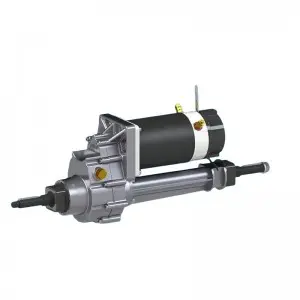The transaxle is a critical component in a vehicle’s driveline and plays a key role in transferring power from the engine to the wheels. It is often confused with a differential, but they have different functions in vehicle operation. For anyone interested in automotive mechanics, it’s important to understand the differences between a transaxle and a differential.
A transaxle is a combination of transmission and axle integrated into a single unit. It is commonly found in front-wheel drive vehicles, where the transmission and front axle are combined into a single unit. This design helps optimize the vehicle’s space and weight distribution and simplifies the overall drivetrain layout. In rear-wheel drive vehicles, the transmission and differential are separate components, with the transmission located at the front of the vehicle and the differential at the rear.
The primary function of a transaxle is to transfer power from the engine to the wheels, while also providing the transmission ratios required for the vehicle to move at different speeds. It contains the gearbox, which is made up of multiple gears that can be switched to change the speed and torque of the wheels. The transaxle also houses the differential, which distributes the engine’s power to the wheels while allowing the wheels to rotate at different speeds, such as when cornering.
A differential, on the other hand, is a component that allows the wheels to rotate at different speeds while receiving engine power. It’s present in all vehicles, whether they are front-wheel drive, rear-wheel drive, or all-wheel drive. The differential is located between the drive wheels and is connected to the transmission or transaxle via the driveshaft.
The main purpose of a differential is to compensate for differences in wheel speed when the vehicle turns. When the vehicle turns, the outer wheels travel a greater distance than the inner wheels, causing them to spin at different speeds. The differential achieves this difference in speed by distributing power to each wheel independently, ensuring smooth and efficient handling when cornering.
In conclusion, the main difference between a transaxle and a differential is their integration and function in the vehicle’s drivetrain. A transaxle combines the transmission and axle into a single unit, primarily used in front-wheel drive vehicles, and is responsible for transmitting power from the engine to the wheels and providing transmission ratios at different speeds. A differential, on the other hand, is an independent component that allows the wheels to rotate at different speeds, compensating for speed differences when cornering and ensuring smooth operation of the vehicle.
It’s important to note that transaxles and differentials are critical to the proper functioning of a vehicle’s drivetrain. Without a transaxle, a front-wheel drive vehicle would be unable to transfer power from the engine to the wheels, and without a differential, all vehicles would have serious problems cornering and cornering.
In summary, understanding the role and differences between a transaxle and a differential is crucial for anyone interested in automotive mechanics. Both components play a vital role in the driveline, ensuring that power is efficiently transferred from the engine to the wheels and that the vehicle operates smoothly and safely through turns and turns. Whether it’s a front-wheel drive vehicle with a transaxle or a rear-wheel drive vehicle with an independent transmission and differential, these components are integral to the vehicle’s overall performance and functionality.
Post time: Jul-26-2024


